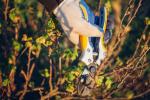Which hedges are snowberries suitable for?
Snowberries are deciduous. The bushes are not suitable as permanent privacy protection.
also read
- Caution: snowberries are slightly poisonous!
- The snowberry or crackling pea - a profile!
- Cutting snowberries - the correct pruning of the crackling pea
The crackling pea is often grown in natural hedges, which are primarily used as food for birds and other insects.
Plant snowberries at a distance of 50 to 100 centimeters from other hedge plants. The gaps close quite quickly because of the rapid growth.
Plant snowberries in the hedge
Snowberries are very undemanding shrubs. You can cope with almost any location. They do not have high demands on the soil quality.
The crackling pea is a typical beginner shrub. Even if you haven't had any previous experience with ornamental shrubs, you won't have any problems with snowberries.
In contrast to many other bird bushes, the snowberry also thrives in shady regions. You can therefore plant them as hedges wherever almost nothing else will grow.
Combine snowberry with other bird bushes
Snowberries look particularly good in combination with other bird bushes, such as:
- Cornelian cherry
- elder
- currant
- Rowanberry
- Snowball
Snowberries hardly need any care
Snowberries are fast-growing. They gain up to 50 centimeters in height each year.
The snowberry in the hedge hardly needs any care. Aside from the occasional pruning and removal of runners, you can leave the shrubs to their own devices. Watering is only necessary in very dry summers. Also on that Fertilize you can do without.
Cut Shape the snowberry in the hedge until April or from mid-July. If you need to make a rejuvenation cut from time to time, you can cut the plant back to the ground. It drives out again very quickly. However, the pruning is at the expense of the berries that hang on the bushes in late summer.
Tips
The snowberry constantly produces new flowers with lots of nectar until September. This makes them particularly valuable for bees, as they can still find food here in autumn.



